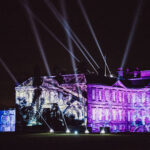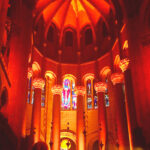The Dynamic Visual Design at MTV’s Video Music Awards
There were any number of standout moments during the 2016 MTV Video Music Awards, broadcast and streamed live from NYC’s Madison Square Garden on Aug. 28. Whether it was Beyoncé, Rihanna, Nick Jonas, Future, or the return of the Pop Princess Britney Spears, certainly the visual design for VMAs yet again raised the bar. As ever, the show’s producers never want to repeat themselves, so it’s no small assignment to design a dynamic and unique environment inside the MSG arena. The task and wonderfully realized design was accomplished by the creative team of production designer Tom Scutt along with art director Matt Steinbrenner; screens producer Laura Frank, principal of Luminous FX; and lighting designer Bob Barnhart of Entertainment Design Group 22˚.

“The VMAs has always been a show that’s very design-forward and design-centric,” explains Steinbrenner. “The art is at the forefront of the process, and they let some conventions of typical award shows fall by the wayside. I think this year was a good example of how that approach resulted in creating a lot of interesting design opportunities for the scenic elements and for the blocking of different performances.”
Scutt’s design incorporated multiple different video scenic elements that really allowed the space to be continuously visual altered. Steinbrenner notes, “One of the interesting things about this year’s show was being able to use the variety of technologies and locations in the room for different performances. We were able to use projection, the rear LED wall, and the lighting rig to really bring the performances out into the room while still being able to use the Hive [the center of the production design — see below] to frame and contain the action to the main stage. We also had the ramp and the tunnel elements that extended out into the room as well. It was great to see how different video content transformed the space throughout the night.”
The main stage was backed by a LED video wall of WinVision Galaxia Electronics Win9 panels. The video wall could be split open for entrances. VER supplied the video equipment and SGPS provided the automation. There was a sweeping ramp with a tunnel space underneath, built by Atomic Design, that had RGB Lights’ FlexiFlex LED string on the interior of the tunnel and LED tape on the exterior to further incorporate video into the element. The floor had Revolution Display’s Blade LED strips in it and on either side of the stage were also tall wing walls with the same Blade LED strips. Those video blades were mounted laterally across the walls on ribs. “Those walls were a static piece of scenery that had a substantial grid of video blades,” notes Steinbrenner, “and they also had a large system of lighting integrated into them. We could use the wing walls to create an extension of our video world or we could use the lighting array. That flexibility let us shape each performance to look different without actually having to change any scenery.”

The Hive
The centerpiece of the production design (not a static element of the design however), was an element referred to by the creative team as “The Hive.” The element consisted of six trapezoidal-shaped panels with a steel structure built by Scenic Express and populated with Huasun Technology’s Flex MESH-50. As described by Steinbrenner, “The Hive consisted of six different individual pieces that could move independently. It could be fully extended to create a full close down, essentially surrounding the stage, or it could be retracted up into the ceiling to create a header above the stage. By using Flex MESH we could use the Hive as a video scrim, where we were able to use the transparency of the LED product to transition in and out of the performance; like for performances by Future and Ariana Grande. Also, we were able to link the movement of the Hive to the video so that the content tracked with the Hive.”
As Steinbrenner previously mentioned, it was a collaboration of the video with lighting that allowed the transformation of the environment throughout the evening. “Laura Frank and Bob Barnhart are great to work with. They are both top-notch and always consider the show as a whole and how it’s going to flow from one performance to another.”
For his part Barnhart started his design looking at the Scutt’s design. “I start first looking at what is the production design; how it lays in to the room; and seeing what it offers,” states Barnhart. “I am looking to see ‘what do I need to cover with lighting?’ ‘Where does my design merge with the production design to bring them together?’ ‘What is expected from the lighting?’ Once we’ve looked at the set itself, now we look at having to light the audience, and starting to put in the tools that are going to allow me to handle all the different performances. Of course when I’m designing the plot you don’t know anything about the performances. We don’t yet know if they’ve got scenery, props, or dancers. We’re trying to lay out a light plot that basically places enough tools in enough places, that we’ll be able to do whatever it’s that’s asked of us when we get there.” He laughingly adds, “Then I still end up standing on stage at some point in time going, “I wish I had a light over there.”

Visual Balance
The VMA lighting rig, supplied by PRG, included Clay Paky Mythos fixtures, Solaris strobes, VL3000 and VL3500 Spots, PRG Best Boy HP’s and Best Boy GroundControl Followspots. One thing Barnhart has learned doing numerous large-scale, performance-heavy award shows and events is that, “You don’t want to waste your budget spreading your light plot out so thin, that although you could get lights everywhere you need them, you would not have enough for the core performance. You don’t want to take a hundred lights off the overhead part of the stage and spread them out over the circumference of the arena. Yes, there’d be a light every 80- or 100-feet, but I’m only going to use them twice, and I will have lost a huge amount of equipment needed for the majority of the performances. It’s about balancing the rig to do what you need with priorities taken into consideration. Then, if we’ve done it right, we can get the rig to do all the different things we need it to for the show.”
He further points out, “That discovery process of what you can do with the rig is very limited on a TV special; it’s
pressure-packed. We started seeing the performance acts on Thursday, then additional new acts on Friday, new acts on Saturday, and then Sunday was the show. As we work on each act, it’s also our responsibility to design the whole show and put it together, not just an individual performance. We try to find new and different looks for each performance that still works within the overall show.”
With so many video elements throughout the arena encompassing the set, Barnhart worked closely with Frank to create a cohesive visual look to the evening. “I am never exactly excited to see a large video wall in a design, because that’s a lighting void,” Barnhart says. “On this one, we also had all those video blades in the walls and the floor, so it was a whole lot of video. We really needed to work together as a team to bring the lighting and the video together. Of course, I was very lucky because I got to work with Laura Frank, who’s fantastic handling media but also has a great history in the lighting world. We become one department in many respects and played along together. It was also great working with Matt [Steinbrenner] and Tom [Scutt.] Tom brings a fresh set of ideas, he’s got more of a theatre background and so he brings a different approach to a show like the VMAs.”

Lighting and Video Teamwork
Laura Frank agrees that the lighting and video teamwork was essential to their success. “It was a very comfortable collaboration. I worked to support Bob and his lighting team’s process by not blowing up the screens; catching situations where we could help them with color and the same thing with content delivery.” Frank also worked with the lighting team to let the video team control the LED tape. She explains, “Because the Hive itself was only video, we wanted to be able to design that video in relationship to the LED tape. We felt it was important to be able to provide accents and rhythms that mimicked the behavior of the video, so we controlled that with the [d3 Technologies’] d3. My engineer, Zak Haywood, was essential in making that work. In the end I think the visual result was stunning, and it really became a multi-departmental effort — you have a scenic installation using a lighting control paradigm driven by the video team.”
So that the creative team, the directors and producers could visualize the video heavy environment of the show, Frank used a previz tool — based on WebGL — that she has developed that’s focused on more accurate visualization of screens content. “I came into the process after the design/development phase,” describes Frank, “and was able to support their creative by using the platform I’ve been developing. With that tool, they could continue to evolve that paradigm they had constructed of what, for example the Hive cage was going to be and how it was going to be used. I helped them answer the visual questions. It was a complicated video environment to unwrap, and I try to help shorten the learning curve around the scenic complexity and help everyone understand the layers of videos they could interact with on the set and how it was going to be seen on camera. We used that previz tool quite a bit, and that meant we could be more productive once in the room because we already had a well-developed understanding of the scenic environment and how it was going to feel through a camera lens.”
The striking visual result is a credit to the team effort. “This show had a number of challenges,” acknowledges Frank, “and we needed to take some risks to achieve the right solutions. Everyone on the team faced the risks openly and together. I think we can be proud of what we achieved.” Steinbrenner completely agrees with Frank, commenting, “The thing that really keeps me engaged with the VMAs is their willingness to take risks. I think that’s such an important part of keeping what we do exciting and innovative. Without risk-taking, there’s so much less
reward.”


